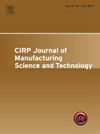Arc length–angle space-based overlap-free asymmetric corner smoothing method for five-axis toolpaths
IF 4.6
2区 工程技术
Q2 ENGINEERING, MANUFACTURING
CIRP Journal of Manufacturing Science and Technology
Pub Date : 2025-01-08
DOI:10.1016/j.cirpj.2024.12.009
引用次数: 0
Abstract
Smoothing of linear toolpaths is critical to ensure quality and efficiency in computer numerical control (CNC) machining, particularly in 5-axis machining. However, existing corner smoothing methods often impose overly restrictive constraints on the transition lengths at corners, increasing curvature extremes and reducing the feedrate. To address this issue, this paper presents a five-axis toolpath asymmetric corner smoothing method based on the arc length–angle space. First, an arc length–angle space analysis method is introduced that can synchronize the tool tip position and tool orientation, decoupling the tool tip position and tool orientation smoothing processes. The tool tip position is smoothed with an asymmetric Pythagorean-hodograph (PH) curve in the workpiece coordinate system, whereas the tool orientation is smoothed with an asymmetric B-spline curve in the arc length–angle space. Then, to prevent overlap of adjacent transition curves, transition length adjustment strategies in the workpiece coordinate system and arc length–angle space are proposed to improve the corner feedrate within the set approximate error range. The simulation and machining experiment results show that, compared with existing asymmetric smoothing methods, the proposed method generates smoother toolpaths and achieves higher machining efficiency.
求助全文
约1分钟内获得全文
求助全文
来源期刊

CIRP Journal of Manufacturing Science and Technology
Engineering-Industrial and Manufacturing Engineering
CiteScore
9.10
自引率
6.20%
发文量
166
审稿时长
63 days
期刊介绍:
The CIRP Journal of Manufacturing Science and Technology (CIRP-JMST) publishes fundamental papers on manufacturing processes, production equipment and automation, product design, manufacturing systems and production organisations up to the level of the production networks, including all the related technical, human and economic factors. Preference is given to contributions describing research results whose feasibility has been demonstrated either in a laboratory or in the industrial praxis. Case studies and review papers on specific issues in manufacturing science and technology are equally encouraged.
 求助内容:
求助内容: 应助结果提醒方式:
应助结果提醒方式:


